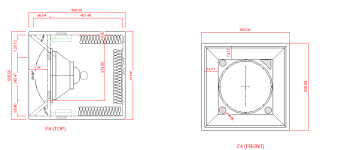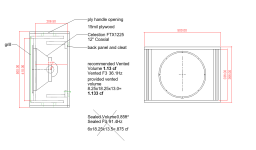The SynTripP is light weight, complicated two-way designed for pattern control to a fairly low frequency.OK. I may have to go Syntrip..LOL
They are checking all the boxs, I just need to put in some more work to get organized. For some reason I I remembered them as being more complicated 3 ways.
Here is how it checks your boxes:
- Not: simple to build
- Won't: sit neatly on top tham15's.
- Kinda:uses lower cost drivers
- Has:90 x 40 degree projection and imaging
- Uses: two sheet of plywood for a pair, if you make no mistakes
- Must: build phase plugs or custom throat adapter.
Understand that the 2x10" SynTripP using the horn extension has about the same low frequency output potential as the single B&C 12CXN88 in a simple front loaded box, and for your application, pattern control in the 400Hz range won't make much difference at all.
No updates, other than the realization that the SynTripP ports are not a very good feature unless running the cabinets below 125Hz.Have there been any updates bat rev 4? I know you weren't to happy with the port performance.
How much DSP/EQ is happening to get that response?
Without the bass reflex ports, the EQ required to flatten response is basically the inverse of the red line, +4dB at 100Hz, -7dB at 700Hz.
With the bass reflex ports, the response around 100Hz is up by +4dB, but the response at 700Hz takes a -12dB nose dive.
The upper response is driver dependent.
Six filters in addition to the BW24 HP/LP and LR24HP were used to flatten the response.
Art
Listeners/dancers really have a different experience with these MEH designs. The difference between being "in" the music vs near the music. It kind of special. Is there any way to achieve a quantity of that in a more simple affordable way ($200-300 driver)?
The best I could do with a 12" coax that fits in a tham footprint is a +- 4" "shallow lens" as mayhem13 suggested, but its at 80d, and some reflex ports. I really have no idea if Im helping or hindering at this point, as opposed to just a coax on a stick design.
- full range, or a minimum naturally flat to 90Hz
- at least 25-50% of synergy style imaging / directivity / throw
- Some +db gains from design as opposed to raw driver power/cost
- preferably fits on the tham15's footprint
- can be 12" coax, or some combination of a smaller coax and some kind of mid/bass loading schema or IDK anything that works
- can work with more expensive drivers as needed .
The best I could do with a 12" coax that fits in a tham footprint is a +- 4" "shallow lens" as mayhem13 suggested, but its at 80d, and some reflex ports. I really have no idea if Im helping or hindering at this point, as opposed to just a coax on a stick design.
Attachments
The difference between MEH and the usual separate horn/woofer is the MEH provides a virtual single point source. The virtual point source is more consistent in response off axis, where many listeners and dancers are.Listeners/dancers really have a different experience with these MEH designs. The difference between being "in" the music vs near the music. It kind of special.
A co-ax driver provides a virtual single point source.Is there any way to achieve a quantity of that in a more simple affordable way ($200-300 driver)?
The Celestion FTX1225 cost around $300.
The more expensive B&C driver DSL uses in the SM-80 has better frequency and polar response, but the single point source effect won't be much different.
I don't know what "bottom end waste energy" is.It sound like porting is creating problems. Is there any way to get some bottom end waste energy without skewing everything?
Ports have a sound quality disadvantage, with a low frequency SPL advantage.
Over +6dB additional SPL at 100Hz in the CKT-FM-FTX1225 system example below, the equivalent of four sealed drivers. A few port tubes are a lot more affordable than doubling drivers and power...
Folded ports are needed for the 36Hz Fb in that undersized box which would have response similar to a sealed box, but offers more cooling.here is a one with no wave guides and volume based on manufactures specs, although seems kind of small to me. Not sure if slot ports are better then PVC?
High aspect ratio slot ports are not better than circular ports, whatever they are made of.
Easier to fold slot ports than circular ports.
Use a 48Hz Fb 48L box and you can get near flat response to 100Hz (on a pole) with the Celestion FTX1225, and could be equalized flat to 48Hz if using it "full range".
https://celestion.com/wp-content/uploads/2018/01/FTX1225_system.pdf
You could change the frontal dimensions to 500mm (or whatever you'd aesthetically prefer) without changing the response, as long as you keep the cabinet volume and ports as specified in the design.
Putting one port above the other, either diagonally or vertically helps transfer heat out of the cabinet, reducing voice coil heating (power compression) and frequency response changes as voice coil impedance rises less.
Art
Ok Im close. But Im near the maximum box size that will fit into a side car door and onto a back seat.
Internal volume is close to manufacture spec after subtracting the hand holds and manufacture recommended ports. I also lost some volume due to the radiused front grille.The gotcha is that Im guessing I need to account for the actual volume of the driver in the box too? which I dont know how to do, but Im sure its going to throw me out of spec.
I attached a PDF of the project so Its easier to read. There are some novice questions in red, some rudimentary cals and some port design options.
Wondering if you guys could give me some feedback on fine tuning this? Do you think this will preform close to the response plot in the post above? Any way to make this design better?
Internal volume is close to manufacture spec after subtracting the hand holds and manufacture recommended ports. I also lost some volume due to the radiused front grille.The gotcha is that Im guessing I need to account for the actual volume of the driver in the box too? which I dont know how to do, but Im sure its going to throw me out of spec.
I attached a PDF of the project so Its easier to read. There are some novice questions in red, some rudimentary cals and some port design options.
Wondering if you guys could give me some feedback on fine tuning this? Do you think this will preform close to the response plot in the post above? Any way to make this design better?

